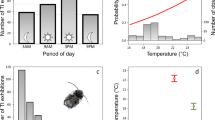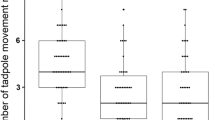Abstract
The idea that tonic immobility (TI) may be a reaction to predation has received increasing support in recent years. It follows, from this view, that distance between predator and prey and opportunity for escape should have predictable effects on immobility. The first experiment showed that the presence of large bushes, as an explicit escape manipulation, reduced immobility durations in anoles (Anolis carolinensis) in comparison to what occurred when they were immobilized in an open area, with the effect being most evident the closer the predator was to the prey. In the second experiment it was shown that close proximity between anoles and the experimenter produced longer durations of immobility in an open area, while a third experiment showed that with bushes nearby this relationship was reversed; that is, shorter durations of TI with anoles in close proximity to the experimenter.
Similar content being viewed by others
References
EDSON, P. H., & GALLUP, G. G., Jr. 1972. Tonic immobility as a fear response in lizards (Anolis carolinensis). Psychonomic Science, 26, 27–28.
GALLUP, G. G., Jr. 1973. Simulated predation and tonic immobility in Anolis carolinensis. Copeia, 3, 623–624.
GALLUP, G. G., Jr. 1974. Animal hypnosis: Factual status of a fictional concept. Psychological Bulletin, 81, 836–853.
GALLUP, G. G., Jr., CUMMINGS, W. H., & NASH, R. F. 1972. The experimenter as an independent variable in studies of animal hypnosis in chickens (Gallus gall us). Animal Behavior, 20, 166–169.
GALLUP, G. G., Jr., NASH, R. F., DONEGAN, N. H., & MCCLURE, M. K. 1971. The immobility response: A predator-induced reaction in chickens. The Psychological Record, 21, 513–519.
GALLUP, G. G., Jr., NASH, R. F., & ELLISON, A. L., Jr. 1971. Tonic immobility as a reaction to predation: Artificial eyes as a fear stimulus for chickens. Psychonomic Science, 23, 79–80.
GALLUP, G. G., Jr., NASH, R. F., & WAGNER, A. M. 1971. The tonic immobility reaction in chickens: Response characteristics and methodology. Behavior Research Methods and Instrumentation, 3, 237–239.
GINSBURG, H.J. 1975. Defensive distance and immobility in young precocial birds (Gallus gallus). DevelopmentalPsychobiology, 8, 281–285.
HEATHWOLE, H. 1968. Relationship of escape behavior and camouflage in anoline lizards. Copeia, 1, 109–113.
HOAGLAND, H. 1928. The mechanism of tonic immobility (“animal hypnosis”). Journal of General Psychology, 1, 426–447.
O’BRIEN, T. J., & DUNLAP, W. P. 1975. Tonic immobility in the blue crab (Callinectes sapidus, Rathbun): Its relation to threat of predation. Journal of Comparative and Physiological Psychology, 89, 86–94.
PARKER, W. S. 1971. Ecological observations on the regal horned lizard (Phyrnosma solare) in Arizona. Herpetologica, 27, 333–338.
PRESTRUDE, A. M., & CRAWFORD, F. T. 1970. Tonic immobility in the lizard, Iguana iguana. A nimal Behavior, 18, 391–395.
RATNER, S. C. 1967. Comparative aspects of hypnosis. In J. E. Gordon (Ed.), Handbook of clinical and experimental hypnosis. New York: Macmillan.
SARGEANT, A. B., & EBERHARDT, L. E. 1975. Death feigning by ducks in response to predation by red foxes (Vulpesfulva). American Midland Naturalist, 94, 108–119.
Author information
Authors and Affiliations
Additional information
Portions of this paper were presented at the meeting of the Southeastern Psychological Association in New Orleans, March 18–21, 1976.
Rights and permissions
About this article
Cite this article
Hennig, C.W., Dunlap, W.P. & Gallup, G.G. The Effect of Distance Between Predator and Prey and the Opportunity to Escape on Tonic Immobility in Anolis Carolinensis. Psychol Rec 26, 312–320 (1976). https://doi.org/10.1007/BF03394393
Published:
Issue Date:
DOI: https://doi.org/10.1007/BF03394393




